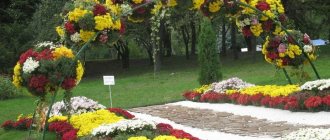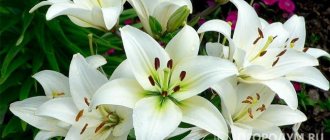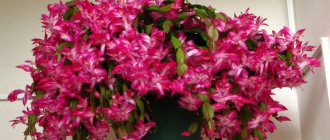Valentina K. When to plant lobelia in open ground? What soil is best for lobelia?
Lobelia is planted in open ground in May. After the night frosts stop. Flowerbeds with these flowers decorate not only sunny areas, but also more shaded areas. When a friendly flowering begins, a carpet of white, purple, and blue flowers of different shades covers the ground. On poor soils, sandstones and loams, lobelia blooms more luxuriantly than on richly fertilized ones.
Seedlings for planting in the ground
Lobelia blooms approximately two months after sowing the seeds. Therefore, in order to wait for flowering at the end of May, the seeds are sown in March. Some gardeners do this even earlier, in February, but then the seedlings will need additional lighting.
Lobelia seeds are laid out on the surface of the soil not singly, but in groups. This will make subsequent care easier. Young plants also sprout in clusters.
Lobelia seedlings are quite resistant to low temperatures (down to -2C), but a sudden change in maintenance conditions can destroy them. Therefore, as soon as sprouts appear, the film is not removed immediately. It should be opened gradually. In this way, already grown seedlings are accustomed to the street. The containers are taken out on calm, windless days for several hours.
Important! When watering seedlings, water should not get on the plants. Shoots nailed down by a stream of water no longer rise.
After picking, when the seedlings have grown by 3-4 cm, the tops are pinched. Plants will become more branched.
Lobelia blossom
Preparing the soil and place for lobelia
Lobelia, planted in nutritious, “fat” soil, actively increases green mass. To prevent this from happening, prepare light, loose soil without nitrogen-containing fertilizers. Preferably with a neutral or slightly acidic pH level. Avoid low places with constant stagnant water. If the plants are kept in flowerpots or flower pots, then prepare the following composition:
- high peat;
- sand (perlite);
- humus (vermicompost).
The parts are taken in a ratio of 3:1:1. To facilitate maintenance, slow-acting fertilizers and hydrogel are applied at the time of planting. Hanging varieties of lobelia look good in hanging baskets.
Advice. Pinch out too long shoots, this way you will get more abundant flowering and a beautiful shape.
General description with photo
In different classification systems, lobelia is classified either in the Lobeliaceae family of the same name, or in the Kolokolchikov family. In nature and in ornamental gardening, the crop is represented by both annual and perennial varieties. It can take the form of a bush, subshrub or herbaceous plant. For growing in the garden, preference is often given to compact species no more than half a meter in height, although some varieties can grow up to 1.5 m. The plant has fragile shoots that branch from the very base of the bush. The peduncles are short, the buds are small, but the flowering is abundant, in bright colors, mainly in blue-blue tones. The first flowers bloom in June, do not last long, but continuously replacing each other, create the effect of continuous flowering until the onset of autumn cold weather. The fruit is a capsule with very small seeds that remain viable for up to 3 years.
Planting lobelia for seedlings depending on the region
Despite the fact that there are generally accepted times when it is recommended to sow lobelia seeds at home, it is very important to take into account the climatic characteristics of each planting region.
- In the southern regions, you can sow seeds already at the end of February.
- For the regions of central Russia, there is no need to rush to plant; it is better to sow in early spring.
- In the northern regions, the Urals and Siberia, seeds are sown in January and February. Since summer does not last long there, it is very important not to be late with planting in order to have time to admire the beautiful flowers.
Varieties of lobelia with photos
The genus includes approximately three hundred species, some of which are grown on an industrial scale for use in the production of medicines. In horticultural culture, only about 20 varieties are grown that are easy to care for, so even inexperienced gardeners should pay attention to them.
The genus is represented by several forms.
- Ampel or cascade. The shoots are thinner and more flexible, lodging type.
- Erect. It has a standard height and almost perfectly straight shoots, making the plant look columnar.
- Compact. A very small, but lush, densely filled bush no more than 15 cm in height.
- Spreading. It forms a loose bush with shoots up to 30 cm, while its height does not reach 20 cm due to its spreading shape.
- Dwarf. The shortest type of lobelia, barely reaching 12 cm.
- Ampelous-bush. A plant of unusual bush shape with shoots directed downwards.
Lobelia erinus (blue)
Annual compact bush up to 25 cm in height. The leaves are small, elongated. Small inflorescences are painted in blue tones. The varietal line may also include white, muted red and some other colors. Blooms throughout the warm season.
Lobelia cardinalis (purple)
Tall, reaching a meter in height, with straight branched stems. The inflorescences are spike-shaped, purple-red. The difference between this species is its preference for waterlogged, swampy soil. The best place for planting it on the site is the banks of reservoirs, hollows, and places where melt and rainwater drain. Characterized by high winter hardiness.
Lobelia Syphilitica
It is very similar to the purple variety both in appearance and in planting preferences and frost resistance, but it blooms in blue-violet tones.
Lobelia fiery
It has tall, up to 75 cm, erect shoots and spike-shaped elongated inflorescences, painted in scarlet tones.
Lobelia Dortman
An endangered species, increasingly rare in the wild. It has bell-shaped flowers of bluish or white color, loves sandy soils.
Lobelia climbing
A climbing perennial of the ampelous type, blooming in a blue and white palette. With high-quality molding, it produces exceptionally lush specimens that bloom so profusely that the bush turns into a blue cloud during flowering. Good for hanging baskets.
Lobelia "Riviera"
It has short and straight, rigid stems and is a dwarf variety, not exceeding 13 cm in height. Grown as an annual. It blooms for a very long time and profusely with small pink-purple corollas of spike-shaped inflorescences.
Lobelia Rosamund
Another popular low-growing annual with sloping stems, red flowers with a white throat. The first buds open 2.5 months from the date of sowing the seeds and continue to replace each other until the soil autumn frosts.
When to plant lobelia seedlings in 2022 according to the lunar calendar
Experienced flower growers, in addition to the generally accepted dates for sowing lobelia, also take into account lunar cycles. Following the recommendations of astrologers helps to obtain magnificently blooming, bright bushes of an unpretentious plant.
Favorable days for planting lobelia in 2022 according to the lunar calendar
Among all the dates, astrologers have identified the following numbers as favorable for planting lobelia
| Month | When is the best time to sow |
| January | from 5 to 7, 11, 15 and 17 |
| February | from 2 to 5, 10 and 12, from 13 to 15 |
| March | 3, from 7 to 9, 11, 14 and 15 |
| April | 6, 7, 10 to 12, 15 and 17 |
| May | 4, 7, 8 to 10, 13, 15 |
INTERESTING! Please note that the favorable days for sowing in 2022 were the first and second ten days of each month.
When is it not worth planting lobelia seedlings in 2022 according to the lunar calendar?
Among the dates when it is better not to plant lobelia, learned astrologers have identified the following dates.
| Month | When not to sow |
| January | 2, 18, 20, 22 and 25, 27, 30 |
| February | 1, 16, 21, 23 and 24, 26, 28 |
| March | 2, 18, 20, from 22 to 24, 27 and 30 |
| April | 1, 16, 22, 25, 26 to 29 |
| May | 16, 21, 23, 25 to 27, 30 and 31 |
On unfavorable days, you should suspend all work related to growing lobelia at home.
How to grow lobelia from seeds?
Growing a crop in open ground begins with planting seedlings at home. Perennial varieties can also be planted in open ground, but in this case flowering this year will be sparse or absent altogether. For annual varieties, planting by seedlings is preferable.
When to sow seeds for seedlings?
Lobelia should be planted early, literally in early February. Then, by the time it is planted in open ground, it will have already formed quite lush bouquets that will be ready for rapid, abundant flowering. However, over such a long period of time, seedlings can become very elongated, especially if there is a lack of lighting; this point should be taken into account in advance and space should be left in the planting container so that as the seedlings grow, soil can be added to them.
Lobelia seeds do not require pre-soaking.
How to sow lobelia for seedlings?
Due to the very small size of the seeds, the planting process can be difficult. Experienced gardeners use the “wet match” method for this. The sulfur-free end is dipped in water and then in a container with lobelia seeds. Those that remain stuck to the match are transferred to a cup with soil. They need to be buried minimally; nothing bad will happen if they remain lying on the surface (we are talking about planting seeds at home, since in open ground light seeds will be blown away by the wind). It is necessary to arrange a mini-greenhouse on top using plastic film, which must be removed daily for ventilation, and after the first shoots removed completely.
Seedling care
If all conditions are met, the first shoots should appear in 2 weeks. From this time on, the shelter will need to either be removed or a number of holes made in it for free ventilation for the first time. The soil should be permanently moist, but care must be taken to ensure that the seeds do not rot in it.
Lobelia is a light-loving plant. In the absence of good lighting, its seedlings will quickly stretch upward, which will not benefit its decorative effect. Even if the containers are on a bright windowsill, it will not be superfluous to provide the seedlings with additional lighting in the evening. Watering young seedlings is carried out using a spray bottle from a sufficiently large distance so as not to nail them to the ground.
Picking
There are no strict rules regarding picking time. You can determine when it will be needed by eye. You need to pick up seedlings several at a time into one cup, without trying to maintain a certain distance between them. This accuracy will ensure the splendor of the future composition.
Important! When picking into cups, soil should be poured into them to no more than a quarter of the height, since it is necessary to leave room for future addition to strengthen the root system and to avoid overly elongated shoots.
Adding soil
As the sprouts grow and stretch, it is recommended to constantly add 1-2 teaspoons of soil under the seedlings until the container is full. Don’t be afraid that some sprout will be covered with soil; this is not critical for this plant; very soon it will come to the surface and acquire additional roots.
Pruning seedlings
This point of caring for young lobelia seedlings can be classified as life hacks for its successful cultivation. As the seedlings grow, shoots that are too elongated should be trimmed with scissors. This must be done without fanaticism, forming neat bushes. Thanks to this haircut, future bushes will look neat, lush and bloom very profusely. Pruning is also recommended for hanging varieties, since weakly leafy, hanging shoots are not highly decorative.
Planting seedlings in open ground
You should begin taking containers with grown seedlings outside for several hours a day with the onset of consistently warm days. Once the air temperature is finally optimized, you can plant it in open ground.
Throughout the entire period of growing seedlings, the soil must not be allowed to dry out, even if you have to water several times a day!
This can quickly lead to irreversible consequences.
How to choose the right seeds
Like any other flower, lobelia needs frequent watering, especially in hot weather. As for the light, don’t worry, this plant will delight you with a neat appearance both in a bright place and in partial shade. It is not afraid of frost; it will continue to flower until the onset of frost.
Lobelia comes in two types: bush and ampelous. You need to choose seeds depending on what kind of plant you want to get. The bushes form a beautiful low ball, the leaves are almost invisible behind their flowers. Ampelous lobelias do not bloom as profusely and require much more effort in care.
To grow healthy and strong seedlings, follow these recommendations:
- Do not forget about regular moderate watering, as lobelia cannot withstand either too dry or waterlogged soil.
- Choose the right lighting. Seedlings need bright, diffused light.
- Harden off, that is, take the plant out into fresh air.
This species can have a bush or ampelous form. Lobelia flowers, depending on the variety, can acquire different shades. The most common buds are purple, white, blue, red and blue. They can grow both in pots on the windowsill and in the garden.
Very often such crops are used in landscape design. Forming a lush ball, they bloom from June to September.
Lobelia care
The most labor-intensive process in the process of growing a crop is the stage of obtaining healthy, full-fledged seedlings. Further care for lobelia is not very difficult, but requires some attention and participation.
Watering
For successful development and abundant flowering, it is necessary that the soil always remains slightly moist. If it dries out completely, you can lose the plant very quickly. During the hot, dry summer period, you may have to water in the morning and evening. This is especially true for specimens grown not in open ground, but in hanging flower pots and floor vases. Due to the small volume of soil in them, rapid drying out is inevitable.
Top dressing
The first feeding can be done when the seedlings are 3-4 weeks old. It should be borne in mind that it can provoke stretching of shoots. In this case, fertilizing should be combined with subsequent pruning. When planted in nutritious soil, the plant can grow successfully with minimal doses of fertilizer. Mineral complexes for petunias are most suitable for lobelia. You can get by by adding nitrophoska or wood ash or alternating them. Nitrophoska is added according to the instructions, wood ash is diluted in water at the rate of 1 tbsp. l. per liter
Trimming
The first pruning, as already mentioned, is carried out at the stage of growing seedlings. Subsequently, pruning the bushes is necessary to preserve their decorative properties and stimulate the formation of new buds. After the first wave of flowering, the shoots are shortened more radically, so that after some time the plant can bloom again. In this case, the second flowering is often more abundant and spectacular.
Once every 3 years, it is recommended to carry out radical anti-aging pruning.
Soil requirements
The culture loves loose and well-permeable soils, grows well on leafy or ordinary garden soil with the addition of sand and vermiculite.
The soil should not be oversaturated with humus, otherwise lobelia may refuse to bloom.
When to plant lobelia seedlings, in what month
Hello dear visitors











